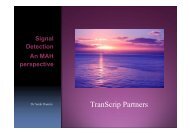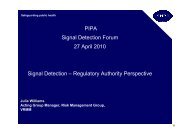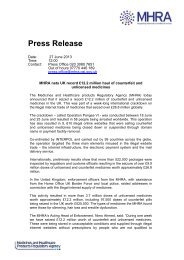Signal Detection at the MHRA - Pipa
Signal Detection at the MHRA - Pipa
Signal Detection at the MHRA - Pipa
- No tags were found...
Create successful ePaper yourself
Turn your PDF publications into a flip-book with our unique Google optimized e-Paper software.
Safeguarding public health<strong>Signal</strong> <strong>Detection</strong> <strong>at</strong> <strong>the</strong> <strong>MHRA</strong>Dr Suzie SeabrokePharmacoepidemiology Unit,Vigilance & Risk Management of Medicines, <strong>MHRA</strong>Crown Copyright ©
Contents• Introduction to The Yellow Card Scheme• <strong>Signal</strong> detection methods <strong>at</strong> <strong>MHRA</strong>• <strong>Signal</strong> prioritis<strong>at</strong>ion‣ Impact Analysis‣ RPPS• Interaction with EMEA• Pilot study of signal communic<strong>at</strong>ion• Future signal detection <strong>at</strong> <strong>MHRA</strong>Slide 2September 2009Crown Copyright ©
The Yellow Card Scheme• Spontaneous reporting scheme established in <strong>the</strong> UK in1964 following <strong>the</strong> thalidomide tragedy• Reports submitted in confidence by healthcareprofessionals and p<strong>at</strong>ients• Reports of suspicions – <strong>the</strong> submission of a report doesnot necessarily mean th<strong>at</strong> <strong>the</strong> drug was responsibleSlide 3September 2009Crown Copyright ©
The Yellow Card Scheme (cont.)• Since 1964: > 600,000 UK spontaneous reports• Currently ~ 25,000 reports received / year• Reports entered onto <strong>MHRA</strong> ADR d<strong>at</strong>abase‣ Drugs coded to in-house drugs dictionary‣ ADRs coded using MedDRA (Medical Dictionary for Regul<strong>at</strong>oryAffairs)‣ P<strong>at</strong>ient demographics, medical history etc.Slide 4September 2009Crown Copyright ©
Autom<strong>at</strong>ed <strong>Signal</strong> <strong>Detection</strong>• Traditional method of reviewing every new report· Large d<strong>at</strong>abase <strong>at</strong> <strong>MHRA</strong>· ~ 500 reports received a weekToo many signals to deal with manually• St<strong>at</strong>istical methods may be used to autom<strong>at</strong>e signaldetection· Identify drug-ADR combin<strong>at</strong>ions th<strong>at</strong> are disproportion<strong>at</strong>ely presentin d<strong>at</strong>abase i.e. observed is gre<strong>at</strong>er than expected‣Focus <strong>at</strong>tention‣Prevent harm - detect possible safety issues ASAPSlide 5September 2009Crown Copyright ©
<strong>Signal</strong> <strong>Detection</strong> Methods Used At The<strong>MHRA</strong>• EBGM (Empirical Bayes Geometric Mean)- currently used for signal detection since June 2006- used for autom<strong>at</strong>ed signal detection within signal detection software• PRR (Proportional Reporting R<strong>at</strong>io)- used previously for between 1997-2006- still used for reference• Both methods identify drug-ADR combin<strong>at</strong>ions th<strong>at</strong> aredisproportion<strong>at</strong>ely presentSlide 6September 2009Crown Copyright ©
<strong>Signal</strong> <strong>Detection</strong> Process <strong>at</strong> <strong>MHRA</strong>• Spontaneous reports are entered onto <strong>the</strong> d<strong>at</strong>abase ondaily basis as <strong>the</strong>y are received• <strong>Signal</strong> scores (PRR and EBGM) are computed every weekfor reports received in previous week• <strong>Signal</strong>s of potential interest are flagged for assessmentbased on preset criteria‣ Different criteria apply for black triangle (▼) and non-black triangle drugs(Non-▼)Slide 7September 2009Crown Copyright ©
Str<strong>at</strong>ific<strong>at</strong>ion/Subsets• Routine d<strong>at</strong>a mining runs are subsetted by:‣ Vaccine / Non-vaccine reports‣ UK / Non-UK reports• Str<strong>at</strong>ified using Mantel-Haenszel approach by:‣ P<strong>at</strong>ient age (0, 1-2, 3-12, 13-18, 19-35, 36-65, 66+, Unknown)‣ P<strong>at</strong>ient gender (male, female, unknown)‣ Time periodSlide 8September 2009Crown Copyright ©
UK Reports - <strong>Signal</strong> Criteria (Non-▼)• Serious reports where EBGM ≥2.5, EB05 ≥1.8, n ≥3 :· All unlisted drug-event combin<strong>at</strong>ions· Listed drug-event combin<strong>at</strong>ions – only those where change infrequency detected (proportion of reports received in last quarter ≥8%)• All f<strong>at</strong>al reports• All reports involving children (≤16 years)• All parent/child reports (including spontaneous abortion)• All reports for ‘Alert’ terms - medical conditions of interestSlide 9September 2009Crown Copyright ©
Examples of Alert TermsAgranulocytosisAlveolitisAplastic anaemiaBlindnessEosinophilia-myalgia syndromeFibrosing colonop<strong>at</strong>hyHep<strong>at</strong>ic necrosisHep<strong>at</strong>ic failureHyperpyrexiaInsterstitial nephritisLimb reduction defectMalignant hyper<strong>the</strong>rmiaMyocarditisNeuroleptic malignant syndromePulmonary fibrosisRenal failure acuteReye’s syndromeRhabdomyolysisStevens-Johnson syndromeSystemic lupus ery<strong>the</strong>m<strong>at</strong>osusThrombocytopeniaTorsade de pointesToxic epidermal necrolysisSuicideSuicidal ide<strong>at</strong>ionSelf-injurious behaviourIntentional overdoseDrug interactionFood interactionSlide 10September 2009Crown Copyright ©
Non-UK Reports - <strong>Signal</strong> Criteria (Non-▼)• All serious unlisted reports where EBGM ≥2.5, EB05 ≥1.8,n ≥5• All f<strong>at</strong>al reports• All reports involving children (≤16 years)• All parent/child reports (including spontaneous abortion)• All reports for ‘Alert’ terms - medical conditions of interestSlide 11September 2009Crown Copyright ©
UK and Non-UK <strong>Signal</strong> Criteria (▼)• Safety profile for newly licensed products not yetestablished• Single case report may <strong>the</strong>refore represent important safetysignal• All serious reports regardless of EBGM score• EBGM/PRR used for reference r<strong>at</strong>her than to filter signalsSlide 12September 2009Crown Copyright ©
Wh<strong>at</strong> do we do with a signal?• Next steps: <strong>Signal</strong> evalu<strong>at</strong>ion‣ Impact Analysis‣ <strong>Signal</strong> prioritis<strong>at</strong>ion‣ Regul<strong>at</strong>ory actionSlide 13September 2009Crown Copyright ©
Impact Analysis• A m<strong>at</strong>hem<strong>at</strong>ical scoring system to aid prioritis<strong>at</strong>ion ofsignals detected from spontaneous ADR d<strong>at</strong>a• Interim step between signal detection and detailed signalevalu<strong>at</strong>ion• Purpose is to focus detailed signal evalu<strong>at</strong>ion on thosesignals th<strong>at</strong> are <strong>the</strong> strongest and are most likely to have animpact on public healthSlide 14September 2009Crown Copyright ©
Impact analysis : inputs• Summarises impact of a signal through two scores:- Evidence (strength of evidence for causality)‣ Mean of EBGM/EB05‣ Strength of evidence from spontaneous reports‣ Biological plausibility- Public health (public health implic<strong>at</strong>ions)‣ Number of cases reported per year‣ Health consequences of <strong>the</strong> ADR‣ Reporting r<strong>at</strong>e over last yearSlide 15September 2009Crown Copyright ©
Regul<strong>at</strong>ory PharmacovigilancePrioritis<strong>at</strong>ion System (RPPS)• System of issue prioritis<strong>at</strong>ion which follows on from ImpactAnalysis and uses some of <strong>the</strong> same principles• Aid to <strong>the</strong> management of multiple dynamic issues in <strong>the</strong>alloc<strong>at</strong>ion of resources• Ensures th<strong>at</strong> appropri<strong>at</strong>e timescales are defined to meet<strong>MHRA</strong>’s public health and o<strong>the</strong>r oblig<strong>at</strong>ions• Aid to pharmacovigilance auditSlide 16September 2009Crown Copyright ©
RPPS – basic structure• Four c<strong>at</strong>egories and an overall priority which is dependenton those c<strong>at</strong>egories:‣ Strength of evidence for a causal effect‣ Potential public health implic<strong>at</strong>ions‣ Public perceptions‣ Agency oblig<strong>at</strong>ions• Overall priority linked to timescalesSlide 17September 2009Crown Copyright ©
<strong>Signal</strong> detection & prioritis<strong>at</strong>ion process<strong>Signal</strong> detectionImpact AnalysisRPPS<strong>Signal</strong> detectionmeeting(s)<strong>Signal</strong> managementreview meeting<strong>Signal</strong> evalu<strong>at</strong>ionRegul<strong>at</strong>ory actionSlide 18September 2009Crown Copyright ©
Interaction with EMEA/Eudravigilance• UK ADR reports are exchanged with <strong>the</strong> EMEA on a weeklybasis• <strong>MHRA</strong> makes use of Eudravigilance as an additional d<strong>at</strong>asource for signal evalu<strong>at</strong>ion on an ad hoc basis• <strong>Signal</strong>s currently shared with EMEA/Rapporteur/RMS forcentralised products where UK is not Rapporteur/RMS• Proposals to share signal inform<strong>at</strong>ion with EMEA in futureSlide 19September 2009Crown Copyright ©
<strong>Signal</strong> Communic<strong>at</strong>ion Pilot Study• Pilot study to test feasibility of a regular, monthly 2-waycommunic<strong>at</strong>ion of safety signals between <strong>MHRA</strong> andmarketing authoris<strong>at</strong>ion holders (MAHs)• Four MAHs took part between July 2007-June 2008• <strong>Signal</strong>s were exchanged on a monthly basis with<strong>MHRA</strong>/MAH proposed timelines for evalu<strong>at</strong>ionSlide 20September 2009Crown Copyright ©
<strong>Signal</strong> Communic<strong>at</strong>ion Pilot Study –Results• 136 potential safety concerns were exchanged• 13% resulted in a change to product inform<strong>at</strong>ion for healthprofessionals and p<strong>at</strong>ients• Agreement between <strong>MHRA</strong>/MAHs on timelines proposedfor evalu<strong>at</strong>ion‣ System was feasible for MAHs involved and indic<strong>at</strong>edpotential benefits of collabor<strong>at</strong>ion for planning andprioritis<strong>at</strong>ion of potential safety concernsSlide 21September 2009Crown Copyright ©
Future <strong>Signal</strong> <strong>Detection</strong> <strong>at</strong> <strong>MHRA</strong>• Ongoing research/evalu<strong>at</strong>ion into best practice forautom<strong>at</strong>ed signal detection methods <strong>at</strong> <strong>MHRA</strong> e.g:‣ Thresholds for signal st<strong>at</strong>istics‣ Background d<strong>at</strong>a for signal st<strong>at</strong>istics‣ Detecting severity/frequency changes• <strong>Signal</strong> exchange with EMEA• Fur<strong>the</strong>r consider<strong>at</strong>ion on implementing exchange withindustrySlide 22September 2009Crown Copyright ©
Crown copyright 2009The m<strong>at</strong>erials fe<strong>at</strong>ured within <strong>the</strong>se <strong>MHRA</strong> present<strong>at</strong>ion notes and deleg<strong>at</strong>epack are subject to Crown copyright protection for this event. Any o<strong>the</strong>r copyor use of Crown copyright m<strong>at</strong>erials fe<strong>at</strong>ured in this present<strong>at</strong>ion, in any formor medium, is subject to prior approval of <strong>the</strong> <strong>MHRA</strong> which has Deleg<strong>at</strong>edAuthority from Her Majesty's St<strong>at</strong>ionery Office (HMSO) to administer Crowncopyright for <strong>MHRA</strong> origin<strong>at</strong>ed m<strong>at</strong>erial. Applic<strong>at</strong>ions should be in writing,clearly st<strong>at</strong>ing <strong>the</strong> proposed use/reuse of <strong>the</strong> inform<strong>at</strong>ion, and should be sentto <strong>the</strong> <strong>MHRA</strong> <strong>at</strong> <strong>the</strong> following address:Conference and Educ<strong>at</strong>ion Function, 16 th Floor,<strong>MHRA</strong>, 1 Nine Elms Lane,London SW8 5NQ.Fax 020 7084 3522e-mail: speakers@mhra.gsi.gov.uk.You may not sell or resell any inform<strong>at</strong>ion reproduced to any third partywithout prior agreement. The permission to reproduce Crown copyrightprotected m<strong>at</strong>erial does not extend to any m<strong>at</strong>erial in this pack which issubject to a separ<strong>at</strong>e licence or is <strong>the</strong> copyright of a third party. Authoris<strong>at</strong>ionto reproduce such m<strong>at</strong>erial must be obtained from <strong>the</strong> copyright holdersconcerned.Slide 23September 2009Crown Copyright ©







